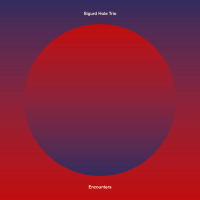Home » Jazz Articles » Multiple Reviews » The Richness of Reich's Repetition
The Richness of Reich's Repetition

 Reich/Richter
Reich/Richter Ensemble Intercontemporain
Nonesuch Records
2022
Steve Reich, along with other contemporary composers such as Terry Riley and Philip Glass, are the upper echelon of minimalist masters who have defined and shaped the sound for decades. For newer listeners, the repeated patterns and shapes Reich presents could seem routine but those willing to remain engaged will discover a wealth of alluring sound waves. Early Reich recordings were heard in the late 1960s and contemporary rock performers including King Crimson and Brian Eno occasionally echoed Reich or paid homage to him. A couple major record labels flirted with him early on but those relationships were short lived. Both ECM Records, and then Nonesuch Records, followed and made firmer commitments.
Through the years, Reich has been influenced by 20th century Neoclassical composers including Bela Bartok, Igor Stravinsky and jazz artists including Miles Davis. But Reich continues to chart his own course. If there are core musical reference points for Reich when he began decades ago, they included repetition, phase shifting and an affinity for 12-tone compositions (in its simplest form, ostensibly predictable but which Reich and the others subtly break out of, almost without the listener realizing it.) And, for those unfamiliar with Reich's music, think back to a time when you sat ocean or lake-side and both listened to, and watched, waves repeatedly cascading toward you. The inevitable repetition soon becomes hypnotic. As time passes, you begin to notice subtle variations that enhance the experience. So to with Reich's music. Patience is rewarded.
In keeping with the parsimonious titles of past Reich works such as Drumming, Music For 18 Musicians and others, the title of this disc— Reich/Richter—is reduced to its essence. The inspiration for the piece came from a work abstract artist Gerhard Richter had created, committed an interpretation of the art to a film and then teamed with Reich for an aural partnership that was paired with the film. The music on this album was recorded live at a 2400-seat venue in Paris in 2020. The fourteen-piece ensemble includes flutes, oboes, clarinets, vibraphones, pianos, violins and more (but, unlike some of Reich's previous works, no vocals this time around.) Augmentation, or the lengthening of notes, dominates the piece. Essentially a four-part work, there's a brisk opening with layers of activity and, as the piece evolves, notes lengthen and slow. It almost enters a stage of quasi-suspended animation. As the piece blossoms, it flirts with delicate, intricate bursts of notes. There's a segment that settles into a serene, soothing state of bliss and then, toward the end of the extended piece, there's a rapid acceleration that leads to an abrupt termination. As with the waves, this piece builds on rich hypnotic elements and, by the end, offers delightful variations rippling just below the surface.
Although the music is an amazingly rich piece and will reward the listener when experienced in the confines of one's home, it's also worth watching to see if a live performance of Reich's work is on the horizon in a city near you. If so, sign up as soon as you can.
 Steve Reich
Steve Reich Nexus and Sō Percussion
Nexus Records
2021
People traditionally clap or applaud after a concert but, in the case of the music presented on the album efficiently titled Steve Reich, a collection of four Steve Reich pieces performed by Nexus, Sō Percussion, this disc opens with "Clapping." It's a deceptively simple piece originally composed in the early 1970s. As with just about all of Reich's works, he crafts a kaleidoscope of aural treats that weave in and out of your mind but rarely leave forever.
The lead musicians of this project include Nexus and Sō Percussion. "Clapping" was originally intended to be performed by one pair of hand clappers sans instruments but this informal group of over a dozen artists start with two players. Additional clappers participate and are added one pair at a time as note relationships shift throughout the piece. The number of clappers is quickly reversed until there's only one pair left at the end of this brisk 3:40-minute piece. "Mallet Phase," a variation of Reich's original "Piano Phase," follows. It's a re-instrumentation by Garry Kvistad played on the unique percussion instruments designed by him. The extended piece is performed first on wooden bars then on tuned aluminum tubes (think wind chimes) and finally back to wooden bars. It becomes a type of relay race as the musician seamlessly hands off one set of instruments to the next with a continuous blending of sounds. An amazing amount of discipline is required when it's performed and, according to Bill Cahn of Nexus, "the musicians were inspired by Reich's phase shifting course of the 1970s that has influenced many other composers and performers in the years to follow." When it seems a few musicians are straying, you quickly realize they are charting a new path that the other soon follow.
"Music for Mallet Instruments, Voices and Organ," composed in 1973, offers, once again, minimal variety due to its repetitive rhythms yet it is both compelling and alluring. Hypnotic and precise percussions are the guiding light for this piece. As Cahn shared with me, "Each of the sections in "Music for Mallet Instruments..." are repeated a number of times, allowing the listener to "feel" (hear and comprehend) the overall sound made by the performers. Variety in the piece consists of nuanced changes in the rhythm and timber of the ensemble from section to section. The listener is challenged to hear and comprehend those nuanced changes." The final piece, "Quartet" (2013), is subtle and cryptic. A pair of vibraphones and pianos toy with each other and bring the disc to a soothing close.
Since a number of Reich pieces are traditionally played 'out of phase,' an incredible amount of concentration on the part of the musicians is required to create the necessary synchronicity with the others while still mesmerizing the listener. Mission accomplished.
Tracks and Personnel
Reich / Richter Tracks: Opening; Patterns and Scales; Cross Fades; Ending.Personnel: Ensemble Intercontemporain.
Steve Reich
Tracks: Clapping Music; Mallet Phase; Music For Mallet Instruments, Voices and Organ; Quartet.
Personnel: Nexus and Sō Percussion.
Tags
Multiple Reviews
Steve Reich
Scott Gudell
Nonesuch Records
Terry Riley
Philip Glass
King Crimson
Brian Eno
Béla Bartók
Igor Stravinsky
Miles Davis
Nexus Records
Nexus
So Percussion
Garry Kvistad
Bill Cahn
PREVIOUS / NEXT
Support All About Jazz
 All About Jazz has been a pillar of jazz since 1995, championing it as an art form and, more importantly, supporting the musicians who make it. Our enduring commitment has made "AAJ" one of the most culturally important websites of its kind, read by hundreds of thousands of fans, musicians and industry figures every month.
All About Jazz has been a pillar of jazz since 1995, championing it as an art form and, more importantly, supporting the musicians who make it. Our enduring commitment has made "AAJ" one of the most culturally important websites of its kind, read by hundreds of thousands of fans, musicians and industry figures every month.





















